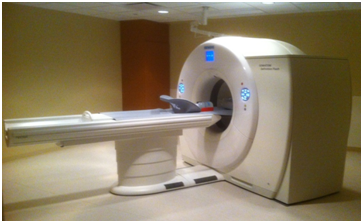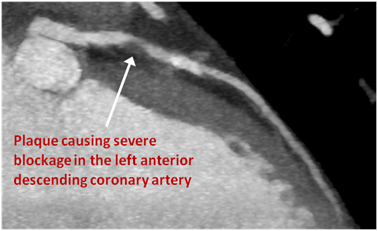Heart muscle, like all other muscles in the body, needs steady blood supply to keep functioning. The arteries that supply blood to the heart muscle are the coronary arteries. “Coronary artery disease” is buildup of plaque (a collection of debris, cells, and cholesterol) in these arteries. Frequency and severity of coronary artery disease tend to increase with age and risk factors such as:
- Smoking
- Family history of heart attack, bypass surgery, coronary artery angioplasty or stent placement, especially first-degree relatives (parents and siblings)
- High blood pressure
- High cholesterol
- Diabetes
The typical individual at risk for coronary artery disease is older than 40 years in age and has one of more of the risk factors listed above.
What problems does coronary artery disease cause?
When plaque in the coronary arteries becomes severe enough to interfere with blood flow to the heart muscle, the affected person can feel symptoms such as chest pain, chest pressure, jaw pain, or breathlessness. In some cases, plaque in the coronary artery suddenly break and trigger a blood clot to form inside the artery, which can then completely block the artery and cause a heart attack. In people who develop problems from coronary artery disease, approximately 50% experience heart attack as their first symptom.
How well does Cardiac CT detect coronary artery disease?
Pictures from Cardiac CT directly show presence of plaque in the major coronary arteries and reliably estimate the degree of blockage caused by these plaque(s). Cardiac CT is an extremely accurate test – more than 95% sensitive in detecting coronary artery disease severe enough to cause symptoms or increase risk of heart attack in the future. At Oklahoma Heart Institute, we use an ultrafast scanner that creates detailed and accurate images of the coronary arteries in less than 10 seconds.

The ultrafast scanner at Oklahoma Heart Institute for cardiac CT.
How does Cardiac CT impact treatment?
For individuals with symptoms that may be due to coronary artery disease or who are concerned about having coronary artery disease, Cardiac CT will find out if there is no disease, mild disease, or severe disease. Absence of disease on CT has been associated with nearly no risk of heart problems in the following 5 years. Presence of coronary artery disease on CT should be discussed with a doctor and may result in more intensive therapy to reduce heart attack risk. Presence of severe coronary artery disease on CT should lead to additional consultation with a cardiologist regarding the benefit of opening up or bypassing the severe blockage(s), particularly if the person has symptoms of coronary artery disease.

Severe blockage in a coronary artery shown on cardiac CT.
What about radiation?
Our imaging technique uses 50% to 90% less radiation than prior generation scanners. This level of radiation is less than other common CT scans, such as CT of the spine, CT of the chest, and CT of the abdomen, and is quite safe for a one-time test.
